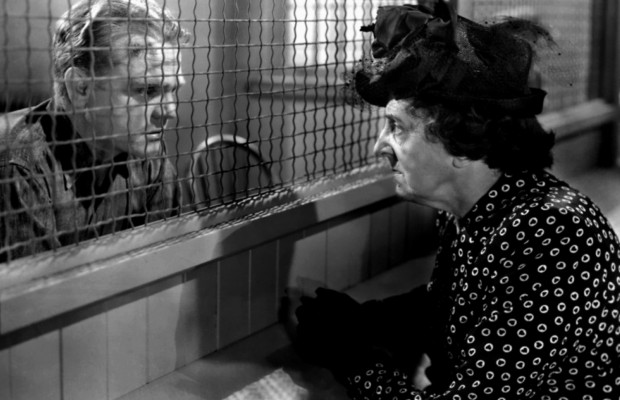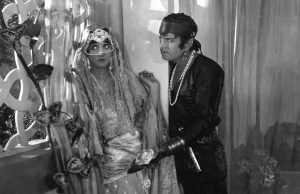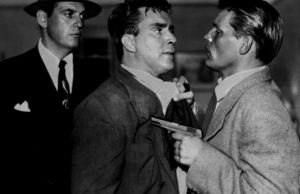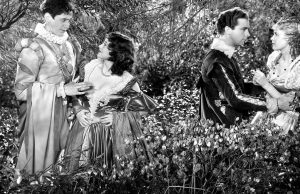White Heat (1949)

Toronto Film Society presented White Heat on Saturday, May 12, 2012 as part of Season 65 May Festival: The Dead Men Don’t Wear Plaid Weekend.
It has been too long since James Cagney has spit a bellyful of lead or laced a guy’s kisser. Cagney is back in that kind of role, and Warners can now start figuring out the potential grosses. “White Heat” is red-hot boxoffice.
 The tight-lipped scowl, the hunched shoulders that rear themselves for the kill, the gargoyle speech, the belching gunfire of a trigger-happy paranoiac—one with a mother complex, no less—these are the standard and still-popular ingredients that constitute the Cagney of “White Heat.” It all strikes a warmly responsive—and nostalgic—chord for those who recall Cagney’s “Public Enemy” days. All that is missing is the grapefruit in a dame’s physiog, in the Cagney manner, but that may be only because grapefruit is not in season.
The tight-lipped scowl, the hunched shoulders that rear themselves for the kill, the gargoyle speech, the belching gunfire of a trigger-happy paranoiac—one with a mother complex, no less—these are the standard and still-popular ingredients that constitute the Cagney of “White Heat.” It all strikes a warmly responsive—and nostalgic—chord for those who recall Cagney’s “Public Enemy” days. All that is missing is the grapefruit in a dame’s physiog, in the Cagney manner, but that may be only because grapefruit is not in season.
The story is not so much the sequence of holdups and murders that comprise this yarn about a modern-day gangleader, but the credence given it by the performance of, mainly, Cagney, as the leader, and, to a lesser degree, the supporting cast. Cagney holds up a train with such authenticity that parents may well rush home, after viewing the picture, and lock up their kids’ Lionels until “White Heat” has played out the neighborhood. When Cagney adds a few extra holes to a guy’s belt—with lead slugs—you just know that the latter has fulfilled his contract for the picture.
“White Heat” specifically is about a killer over whom only his mother can wield any influence. He heads a western gang, with his mother and his double-dealing wife along for company. The romantic triangle, such as it is, is completed by the presence of Cagney’s chief lieutenant, who covets Cagney’s leadership, and also his wife.
When there looms a rap for a train-robbery that he’s engineered, along with a couple of incidental killings, Cagney gives himself up in another state ane “confesses” to a minor crime, for which he gets a short stretch. By this means he is alibied for the former. The Feds, however, are hep to his scheme, and plant a cellmate to gain his confidence and thus circumstantially  break down the alibi. There’s a jail break and a finale shooting scene between the T-men and the Cagney gang—during the frustrated holdup of a chemical factory payroll—that is in the Cagney tradition. When cornered he pumps lead into a chemical vat—and is blow to bits.
break down the alibi. There’s a jail break and a finale shooting scene between the T-men and the Cagney gang—during the frustrated holdup of a chemical factory payroll—that is in the Cagney tradition. When cornered he pumps lead into a chemical vat—and is blow to bits.
Cagney has an excellent supporting cast. Steve Cochran makes a good-looking, double-crossing mobster’s aide whose ambition for the gang leadership, and the leader’s wife, ends in a rain of bullets. It’s a capable performance. Virginia Mayo has little to do except look sexy as the wife. Edmond O’Brien is fine as the undercover agent, and Margaret Wycherly is quietly effective as the mother. John Archer, as another Fed agent, is effective also.
Production is first rate, and Raoul Walsh’s direction has kept the pace sharp and exciting for the nearly two-hour length.
There are several story flaws to “White Heat,” but this is neither the time nor the place to be too technical. This Cagney fellow is murder!
VARIETY, Kahn., August 24, 1949
WHITE HEAT, screen play by Iven Goff and Ben Roberts, from a story by Virginia Kellogg; directed by Raoul Walsh; produced by Louis F. Edelman for Warner Brothers. At the Strand.
Warner Brothers weren’t kidding when they put the title “White Heat” on the new James Cagney picture, which came to the Strand yesterday. They might have gone several points higher in the verbal caloric scale and still have understated the thermal intensity of this film. For the simple fact is that Mr. Cagney has made his return to a gangster role in one of the most explosive pictures that he or anyone has ever played.
If that is inviting information to the cohorts of thriller fans, whose eagerness this reviewer can readily understand, let us soberly warn that “White Heat” is also a cruelly vicious film and  that its impact upon the emotions of the unstable or impressionable is incalculable. That is an observation which might fairly be borne in mind by those who would exercise caution in supporting such matter on the screen.
that its impact upon the emotions of the unstable or impressionable is incalculable. That is an observation which might fairly be borne in mind by those who would exercise caution in supporting such matter on the screen.
For there is no blinking the obvious: the Warners have pulled all the stops in making this picture the acme of the gangster-prison film. They have crammed it with criminal complications—some of them old, some of them glittering new—pictured to technical perfection in a crisp documentary style. And Mr. Cagney has played it in a brilliantly graphic way, matching the pictorial vigor of his famous “Public Enemy” job.
Indeed, as the ruthless gang-leader in this furious and frightening account of train-robbery, prison-break, gang war and gun fighting with the police, Mr. Cagney achieves the fascination of a brilliant bull-fighter at work, deftly engaged in the business of doing violence with economy and grace. His movements are supple and electric, his words are as swift and sharp as swords and his whole manner carries the conviction of confidence, courage and power.
If you think Mr. Cagney looked brutal when he punched Mae Clark in the face with a ripe grapefruit in “Public Enemy,” you should see the sweet and loving things he does to handsome Virginia Mayo, who plays his low-grade wife in this film. Or you should scan the exquisite indifference with which he “lets a little air” into the trunk compartment of an auto in which is locked a treacherous
And Mr. Cagney’s performance is not the only one in this film. Director Raoul Walsh has gathered vivid acting from his whole cast. Miss Mayo, in fact, is excellent as the gangster’s  disloyal spouse—brassy, voluptuous and stupid to just the right degree. And Edmund O’Brien does a slick job as a Treasury Department T-man who gets next to the gang-boss in prison and works into a place of favor in his mob. Steve Cochran is ugly as an outlaw, John Archer is stout as a Treasury sleuth and Margaret Wycherly is darkly invidious as the gangster’s beloved old “ma.”
disloyal spouse—brassy, voluptuous and stupid to just the right degree. And Edmund O’Brien does a slick job as a Treasury Department T-man who gets next to the gang-boss in prison and works into a place of favor in his mob. Steve Cochran is ugly as an outlaw, John Archer is stout as a Treasury sleuth and Margaret Wycherly is darkly invidious as the gangster’s beloved old “ma.”
Perhaps her inclusion in the story is its weakest and most suspected point, for the notion of Mr. Cagney being a “mama’s boy” is slightly remote. And this motivation for his cruelty, as well as for his frequent howling fits, is convenient, perhaps, for novel action but not entirely convincing as truth.
However, impeccable veracity is not the first purpose of this film. It was made to excite and amuse people. And that it most certainly does.
NEW YORK TIMES, by Bosley Crowther, September 3, 1949
Notes compiled by Caren Feldman










Leave a Reply